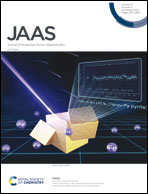Sanidine in obsidian and its applicability in neutron flux monitor development for 40Ar/39Ar dating†
Abstract
The neutron flux monitor is a critical part of the process of 40Ar/39Ar dating. Sanidine in tuffaceous rocks is the best choice for this role, but the currently used standards are mainly cenozoic due to the difficulty in preserving the tuff. Here, we report a new protocol to prepare a neutron flux monitor from the sanidine contained within obsidian, a rock which has undergone rapid eruption and cooling on the surface. The results show that the sanidine in Yunshan obsidian has a homogenous K (7.95 ± 0.18 wt%) and Ca (0.15 ± 0.01 wt%) content, and has no significant intragrain differences in the major elements. The 40Ar/39Ar ages range from 93.29 ± 0.46 Ma (2 se) to 93.49 ± 0.29 Ma (2 se) calculated from the step heating method and are 93.74 ± 0.31 Ma (2 sd) at the single grain level. The variations in zircon SIMS U–Pb ages (93.80 ± 0.58 Ma, 2 sd) and the sanidine 40Ar/39Ar ages did not exceed analytical uncertainties. We propose the development of older (>∼65 Ma) neutron flux monitor standards from obsidian instead of tuff, as it is readily available in the field and a large amount of neutron flux monitor can be prepared from it for daily use.

- This article is part of the themed collection: JAAS HOT Articles 2022


 Please wait while we load your content...
Please wait while we load your content...